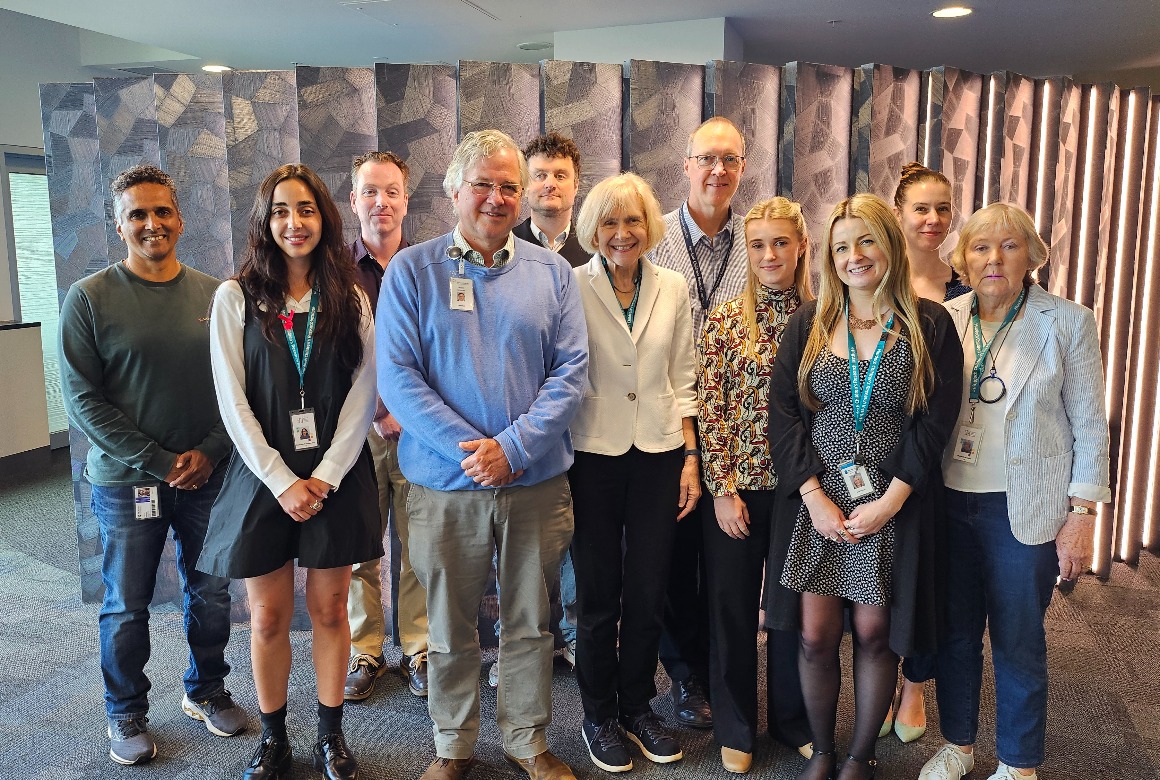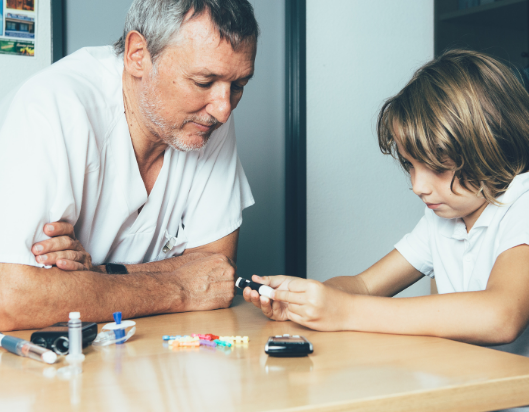Diabetes
Focussing on the impact of diabetes on the developing brain, mental health and quality of life.
We aim to:
- Clearly define the impacts of type 1 diabetes on the developing brain.
- Define optimal utilisation of diabetes-related technological tools and clinical care pathways in the care of children and adolescents.
- Make non-physiologic subcutaneous insulin therapy a second-line rather than first-line therapy in type 1 diabetes.
- Trial novel therapies in youth with type 2 diabetes.
In the past five years, the Murdoch Children's Research Institute Diabetes group have presented 37 abstracts at various scientific meetings. Our work was selected for the President’s Oral Session at the American Diabetes Association's 75th Scientific Sessions, 2015. Our group has won the Best Oral Presentation Award. International Society for Pediatric and Adolescent Diabetes Annual Conferences on five occasions (2008, 2012, 2015, 2017 and 2018).
Our national and international profile and the work of the MCRI Diabetes Group have been well canvassed and have had a significant impact on clinical practice at an international, national, and state level. The areas of greatest impact are an awareness of the impacts of diabetes on brain development and mental health, the importance of metabolic goal setting in clinical care and techniques for measuring glycaemic variation on continuous glucose measurement data sets.
Our group has:
- Been one of the first to highlight the high prevalence of DSM IV mental health disorders in adolescents with type 1 diabetes.
- Been the first to show that childhood diabetes is associated with the ‘rule of thirds’ - loss of one-third of a standard deviation in full-scale IQ, one-third of children have a mental health diagnosis, one-third of children do not complete secondary schooling and one-third of children drop out of adult care within two years of transition.
- Conducted the first RCT in the world of sensor-augmented insulin pump therapy.
- Derived a new metric (CONGA) for measuring glycaemic variation in continuous glucose measurement datasets and defined minimal dataset qualities for accurate measurement.
- Been the first to conduct an RCT of case management of adolescents as they transition to adult care- showing that the intervention increased the frequency of attendance post-transition.
- Derived a new questionnaire-based approach that predicts success or otherwise in patients when adopting diabetes technology in their clinical care.
- Shown that subclinical cerebral oedema occurs during diabetic ketoacidosis and that this predicts cognitive outcomes in the medium term.
- Defined novel robust and repeatable functional MR outcomes (ASL and BOLD) when brains are exposed to hypo- and hyperglycaemia. These provide novel targets for intervention trials.
- Been the first to show that altered connectivity of the default mode network in brain activity results from hypo- and hyperglycaemia.
MCRI Diabetes group

From left to right: Velandai Srikanth (Monash University), Stephanie Antonopoulos (MCRI), Chris Moran (Monash University), Fergus Cameron (MCRI), Chris Adamson (MCRI), Eva Feldman (UniMichigan), Richard Beare (MCRI/Monash), Caroline Nicholas (MCRI), Amy Brown (MCRI), Taya Collyer (Monash) and Elisabeth Northam (MCRI)
More information
Group Leaders

Team Leaders

Group Members












Our projects

CLARiFY diabetes complications study
The Cognition and Longitudinal Assessments of Risk Factors over 30 Years (CLARiFY) diabetes complications study is identifying lifelong factors that impact brain health and outcomes in Type 1 Diabetes
Read more...Define optimal utilisation of diabetes-related technological tools and clinical care pathways in the care of children and adolescents
- Collaborating with the Australian Paediatric Diabetes Technology Research Consortium in various diabetes technology clinical trials.
- Assess the priority given by parents of children with type 1 diabetes for specific diabetes support compared to extra generic school support using the Discrete Choice Experimentation methodology.
- Study outcomes of primary care in diabetes diagnosis using the DIRECT T1DM (Decision-support for Integrated Real-time Evaluation & Clinical Treatment of Type 1 Diabetes Mellitus) tool with the Hiscock MCRI Group.
- Study the Diabetes RAMP (Remote assessment module via Portal) to assess the empowerment of families to enhance self-management skills, reduce unplanned contact with the healthcare team and enhance mental health screening.
Make non-physiologic subcutaneous insulin therapy a second-line rather than first-line therapy in type 1 diabetes
- Establish a T1D Immunotherapy Centre at RCH/MCRI and for this to be the major paediatric diabetes immunotherapy centre in Australasia (external collaborators-Australian T1D Immunotherapy Collaborative (AusT1D) with the Stanley and Pellicci MCRI group.
- To complete The BANDIT trial (Baricitinib in New-onset type 1 Diabetes Trial) in 2023 with St Vincent’s Institute, the Royal Melbourne Hospital and The Women’s and Children’s Hospital, Adelaide.
- Start to establish immunotherapy in T1D as a standard of care (similar to an oncology model) where every newly diagnosed child will be enrolled in a clinical trial with the Diabetes Immunotherapy Consortium.
- Immunologically phenotype children with T1D to define what would be optimal immunotherapies with the Stanley and Pellicci MCRI Groups and the St Vincent’s Institute.
- Generate new candidate immunotherapeutic agents using an iPSC “diabetes in a dish” model with Stanley and Pellicci MCRI Groups and the St Vincent’s Institute.
Trial novel therapies in youth with type 2 diabetes
- Commence trials with novel oral hypoglycaemic agents in Type 2 diabetes with the Melbourne Children's Trials Centre (MCTC).
Funding
- The Program for Neurology Research and Discovery, University of Michigan
- The Royal Children’s Hospital Foundation
- National Institutes of Health, USA
- Juvenile Diabetes Research Foundation
- University of Melbourne, Networked Society Institute
Collaborations
- Australian T1D Immunotherapy Collaborative (AusT1D)
- St Vincent’s Institute, Melbourne
- The Royal Melbourne Hospital
- Walter and Eliza Hall Institute
- Women’s and Children’s Hospital, Adelaide
- Westmead Children’s Hospital, Sydney
- Australian Paediatric Diabetes Technology Research Consortium
- Princess Margaret Hospital, Perth
- Women’s and Children’s Hospital, Adelaide
- Westmead Children’s Hospital, Sydney
- Academic Unit, Medicine, (Peninsula clinical School), Monash University
- Department of Neurology, The University of Michigan
- The Florey Institute, University of Melbourne
- Hvidovre International Study Group on Childhood Diabetes
- Department of Paediatrics, University of Cambridge
Featured publications
- Routine psychological screening in youth with type 1 diabetes and their parents: a notion whose time has come?
This was the first paper to highlight and synthesize the literature showing that adverse mental health outcomes are the leading complication of type 1 diabetes in youth. At the time this paper was written psychological screening in youth with diabetes was rare and mental health care was not seen as a core component of clinical care. Now all the consensus clinical practice guidelines include mental health care support. Diabetes Care 2007; 30:2716-2724. Cameron FJ, Northam EA, Ambler G, Daneman D - Psychosocial well-being and functional outcomes in youth with type 1 diabetes 12 years after disease onset.
This was the first publication to demonstrate adverse mental health and neurocognitive outcomes associated with the onset of type 1 diabetes during youth. Diabetes Care 2010; 33:1430-1437. Northam EA, Lin A, Finch SJ, Werther GA, Cameron.
- Neurological consequences of diabetic ketoacidosis at initial presentation of type 1 diabetes in a prospective cohort of children.
This is a prospective controlled study that investigates the morphological, biochemical, and functional impacts of diabetic ketoacidosis (DKA) at the time of T1DM diagnosis upon the brain. We showed for the first time that DKA is associated with regional and generalised white matter swelling and grey matter shrinkage with reduced neuronal function as measured by brain n-acetylaspartate. The degree of brain swelling, or shrinkage correlates with memory and attention 6 months after T1DM onset. This study established that episodes of DKA are key clinical events in determining brain development in T1DM. Diabetes Care 2014; 37:1554-62. Cameron FJ, Scratch SE, Nadebaum C, Northam EA, Koves I, Jennings J, Finney K, Neil JJ, Wellard RM, Mackay M, Inder TE. - Care of diabetes in children and adolescents: controversies, changes, and consensus.
This invited review canvassed the issues in the current state of flux in the management of paediatric diabetes and highlighted the importance of neurological outcomes. Lancet 2015; 385: 2096–106. Cameron FJ, Wherrett D. - Type 1 diabetes and impacts upon the developing brain.
This invited review summarised the literature (much of it our work) in a rapidly evolving field and provided new insights as to which dysglycemic insults in T1D are most injurious to the developing brain. Lancet Child Adol Health 2019; 3:427-436. Cameron FJ, Northam EA, Ryan CM.
